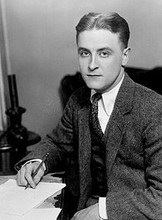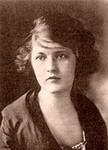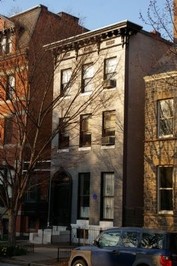F. Scott Fitzgerald at 1307 Park Avenue - Historical Marker
Introduction
Text-to-speech Audio
Images
F. Scott Fitzgerald, c. 1921. He is most well-known for his novel "The Great Gatsby." Many high school students in public schools are required to read this book in an English class.

Zelda Sayre in 1917. Zelda was diagnosed with schizophrenia in 1930. Her downward spiral led Fitzgerald into one of his own, where he became closely acquainted with alcoholic beverages

1307 Park Avenue is still a residential building. The public is welcome to look at and take pictures of the historical marker, but they are unable to view the inside of the building.

Backstory and Context
Text-to-speech Audio
The house located at 1307 Park Avenue in Baltimore, MD was once the residence of writer F. Scott Fitzgerald. Considered one of the greatest authors of the 20th century, he and his family lived here in Boston Hill from August of 1933 until October of 1935. Fitzgerald wrote two novels while living here; the first, Tender is the Night, was published in 1934, and the second, Raps at Reveille, was published in 1935. He also drafted a series of essays here that would later go on to be published under the title of The Crack-up. His house is delineated by a round blue plaque on front of the house, marking it as part of the Boston Hill Historic District. The plaque contains his name, birth and death dates, and significant accomplishments while living there. The house itself was built in 1900 and is classified as a townhouse. Gray brick was used for the exterior of this three-story home. There are four bedrooms and four bathrooms. The house is in walking distance from a monument to Francis Scott Key, who wrote the lyrics to the Star-Spangled Banner; he was a distant cousin of Fitzgerald’s and the person his parents named him after.
F. Scott Fitzgerald moved to this house with his wife, Zelda, and his daughter, Frances Scott Fitzgerald, who they called Scottie. They were forced to find a new home after Zelda, who had been diagnosed with schizophrenia in 1930, had a breakdown and burnt their previous house to the ground. Zelda was put in a hospital upon moving to Baltimore. At the start of his career, Fitzgerald and his family had been living an extravagant life in New York. Now, however, Fitzgerald’s writings were less and less successful, and he was struggling to pay rent. He finished Tender is the Night, his first novel in ten years, in the hopes that it would kickstart his career again. Instead, it was met with lukewarm reviews. Only 13,000 copies sold. This, on top of Zelda’s hospitalization, led Fitzgerald to drink heavily. He would continue to do so for the remainder of his life. After a few more unsuccessful writing attempts, he moved his family to a different part of Baltimore.
Despite its historical significance, this house is still used as a residential building. It was not officially recognized as a historic site until 2003. The idea for the blue plaques was developed by historian and Boston Hill resident Frank Shivers, who modeled it after historic plaques in London that have been in place since 1867. With the help of his neighbor, Polly Duke, he was able to take his idea to Baltimore’s Commission for Historical and Architectural Preservation, the group in charge of maintaining the exterior of Baltimore’s historic buildings. In December 2001, the plan was approved. Ellen Lupton, a graphic designer who lived in Boston Hill, designed the plaques, each of which would cost $170 to create and install. Shivers and Duke received a $500 grant from the Mount Royal Improvement Association, which is known today as the Boston Hill Community Association. They collected the rest of the money needed in the form of donations. With the money they raised, they were able to install 23 plaques initially. 13 more plaques were added in 2013. A comprehensive map is available through the Boston Hill Community Association.
Sources
Busta-Peck, Christopher. F. Scott Fitzgerald. Historical Marker Database. March 22, 2008. Accessed December 08, 2018. https://www.hmdb.org/marker.asp?marker=6473.
Dennies, Nathan. F. Scott Fitzgerald at 1307 Park Avenue. Baltimore Heritage. Accessed December 08, 2018. https://explore.baltimoreheritage.org/items/show/176.
Gunts, Edward. Who was in Bolton Hill. The Baltimore Sun. December 17, 2001. Accessed December 08, 2018. http://articles.baltimoresun.com/2001-12-17/features/0112170044_1_bolton-hill-lived-in-bolton-plaques.
New "Blue Plaques" to be installed. The Bolton Hill Community Association. Accessed December 08, 2018. https://boltonhillmd.org/new-round-of-blue-plaques/.
O-Connor, Kate. The Curious Life of F. Scott Fitzgerald. University of Oxford: Great Writers Inspire. Accessed December 08, 2018. http://writersinspire.org/content/curious-life-f-scott-fitzgerald.
Pousson, Eli. Bolton Hill Blue Plaques. Baltimore Heritage. February 26, 2015. Accessed December 08, 2018. https://baltimoreheritage.org/project/bolton-hill-blue-plaques/.
Rittelman, Linda. BCHA is the new MRIA. The Bolton Hill Community Association. Accessed December 08, 2018. https://boltonhillmd.org/new-name-new-face/.
Rudacille, Deborah. F. Scott Fitzgerald in Baltimore. Baltimore Style. Accessed December 08, 2018. https://baltimorestyle.com/baltimore_f_scott_fitzgerald_in_baltimore/.
